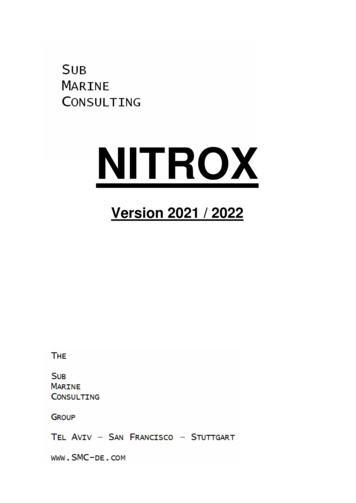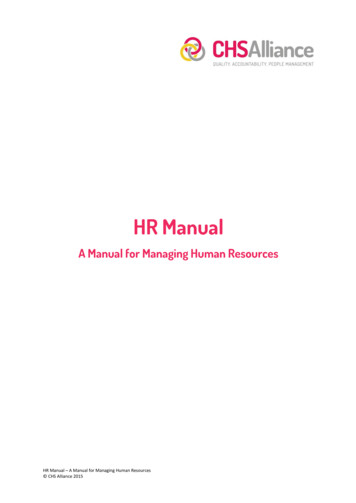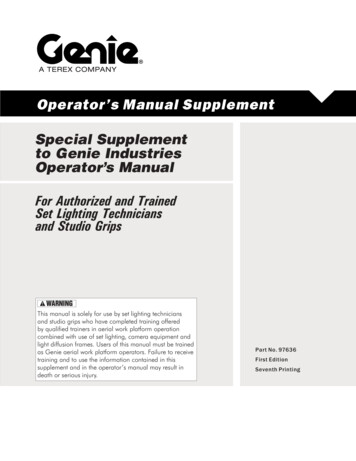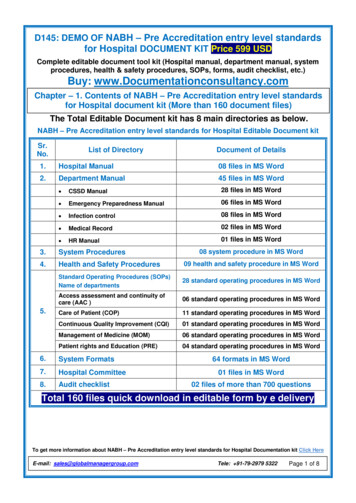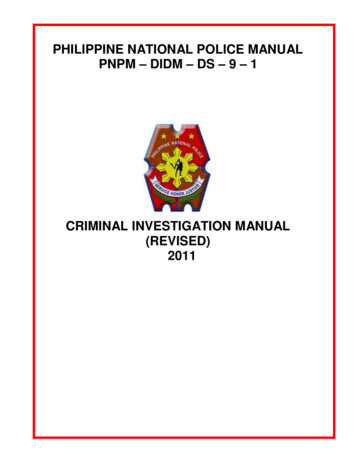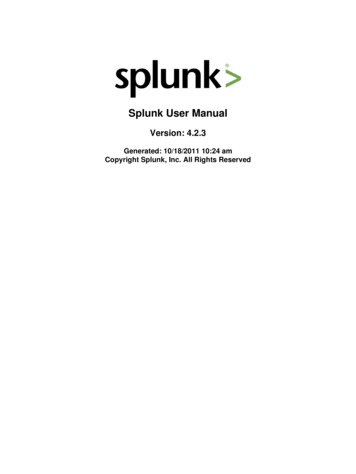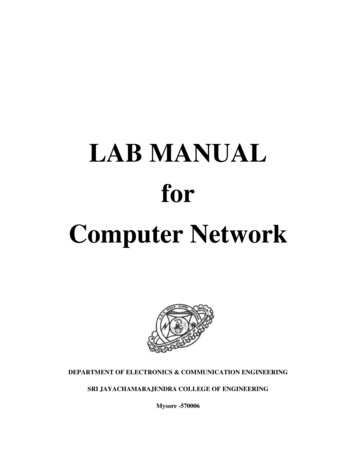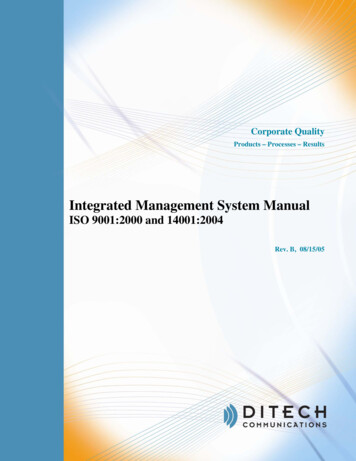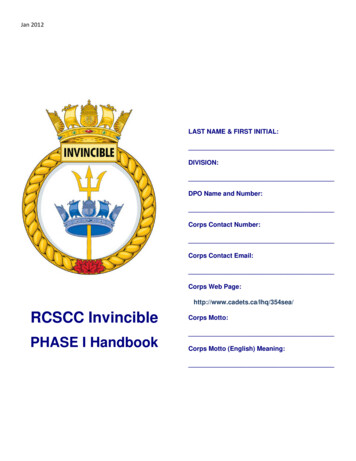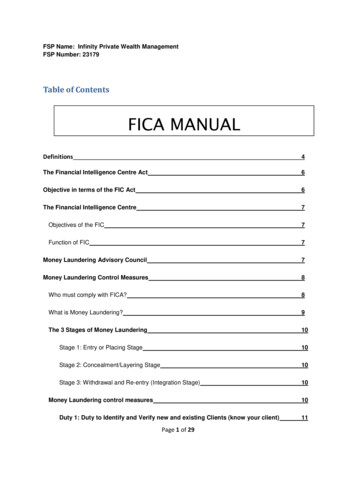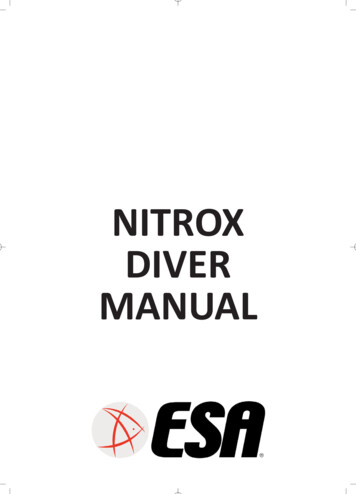
Transcription
NITROXDIVERMANUAL
ESA WorldWideNo part of this book may be reproduced in any formProduct n M0011Editor: Mauro BertoliniFormative project, development, consulting and revision:Mauro Bertolini, Mario Romor, Miho Tsuruoka, EgidioTrainito, Maria Laura CaredduText and photos: Mario RomorIllustrations: Stefano Trainito, Jacopo Pasqualotto
IndexChapter OneNew chances7 What will You learn?7 Nitrox8 Definitions10 Calculations14 Planning20 Diving21 Analysing O224 Congratulation!25 What have You learn?Chapter Two262630333537404243What will you learn?MiscellaneousEquipmentRechargingOxigenCNS oxygen clockManaging emergenciesCongratulation!What have You learn?Chapter Three47 Open Water dives 1 and 251 9 rules for diving with NitroxAppendix52545556575860ESA9 Suggestions to preserve the aquatic environmentNot to be left at homeNOAA dive table of O2 exposition and conversion tablesFormulasESA EAN 36 – EAN 32 – AIR DIVE TABLESO2 analisys3
4
Chapter OneN e w c h a n c esIt’s a beautiful day, the sky is clear, the sea iscalm and the temperature is warmoutside and in the water as well.These are the perfect conditions todive on the KT, one of the most interesting and well kept wrecks of theMediterranean Sea.1Karen and Denise, two ESA WreckDiver licensed divers, are enthusiast: the good weather conditionsand the favourable sea state letthem have a great dive, and now,back on the boat, they are discussing it with Robert, the Diveleaderwho escorted them. One only regret:“It’s a pity the dive was so short!”Several minutes later, while thethree divers are still talking, another group of divers emerge. Theyare guided by Lucy, the otherDiveleader that works at the divingcentre. After the divers are onboard,Karen asks Lucy why they dived forlonger and if a decompress stop wasneeded.Lucy explains that, according to therules of the diving centre, divesexceeding the no decompressionlimits are forbidden, and that sheand the other divers could stay longer because they used a gas mixsimilar to air, but with less nitrogenand more oxygen: Nitrox.Karen and Denise, happy for chanceto dive longer, ask Robert to useNitrox during the second dive, so that they couldvisit the bow of the boat, that is surrounded bymany fish such as corvinas and groopers.Robert tells them that is not possible to dive withNitrox because there are not enough cylindersand they need to be trained to use it.5
The mostgreater timegranted bythe Nitroxallows amore accurate explorationNeedless to say that, after noting that they mustfinish their second dive before than the otherdivers that are using Nitrox, the two friends decide go get informed the ESA Nitrox Diver course.Getting the ESA Nitrox Diver license is reallyeasy; this manual and your ESA Nitrox DiverInstructor will provide all the information neededto diver longer without exceeding the no decompression limits, using properly the two most common Nitrox mixes: NOAA Nitrox 1 and NOAANitrox 2 (i.e. Nitrox with 32% and 36% of oxygenrespectively).You will learn to analyse the gas mix what youwill use, to plan your dives and to monitor exposure to oxygen.During your course the ESA Nitrox DiverInstructor will show how to perform all neededactions and will give suggestions on the bestusage of the “hyper-oxygenated” gas mixes, inorder to take advantages from their potentialityavoiding any potential problems.Read and answer the questions you find in the“miniquiz” and the “What have you learned?”questionnaires, start this new adventure and addyour new important license to your collection.The ESA Nitrox Diver license enables you torecharge and hire Nitrox cylinders, dive withNitrox and satisfy the need to have it as a prerequisite for other courses.This manual deals with the new limits established for recreational dives with Nitrox; anyhow,your new license does not authorize you to gobeyond the limits of your main license. Forinstance, the limits for an ESA Open Water Diver(or similar license released from other organisations) is 18 metres without exceeding the nodecompression limits.If you have not done it already, in order to betteruse the potentiality if Nitrox, you may think toattend the ESA Advanced Diver course, in orderto extend your depth limit to 30 metres, alwayswithin the no decompression limits.6The ESA Nitrox Diver program can be carried outduring other courses, such as ESA Open WaterDiver and ESA Advanced Diver; ask your instruc-
tor what you need to do to get the two licensesduring two integrated training programs.What will you learn?Knowing the composition of Nitrox, its effects,how planning dives correctly and getting readyfor them makes the divers fully use the potentialities of hyper-oxygenated gas mixes (or withreduced amount of nitrogen) without exposingthemselves to risks.What is Nitrox? What are the associated risks?What do I need to do to plan dives with Nitrox?How can I prepare my dive at the best? Howshould I behave while diving? How will I analyzethe gas mix and check the oxygen percentage?You will find the answers to the above and otherquestions in this chapter. The information youwill get will be useful already during the firstdive; should you have any doubts or additionalquestions, don’t hesitate to ask your ESA NitroxDiver Instructor.NitroxThe word Nitrox is composed by two words:nitrogen and oxygen,the two main gassesthat constitute the airyou breath everyday.The air can be considered to be a Nitrox mixwith 21% of oxygen,that is the “normal”percentage of oxygencontained in the air.Such a mix, with 21% ofoxygen and 79% ofnitrogen is called air,while the word “Nitrox”is specially used to indicate an oxygen enriched air mix. By Nitroxwe intend all thosebreathable mixes with more oxygen and lessnitrogen.You can easily understand that, in order to maintain the overall equilibrium and pressure of agiven amount of air, you need to increase thequantity of oxygen when reducing the amount ofnitrogen.1The Nitroxcertification thatyou willreceive isessential toparticipateto immersions withthe Nitrox7
Minitest1. True or FalseThe gas mixture preparation must be performed byrecreative divers.2. The word Nitrox iscomposed from thenames of:a. Nitrogen and oxygenb. Oxygen and dioxide ofcarbonc. Nitrogen and helium3. The denominatedmixture NOAA Nitrox 1are essentially composed from:a. 21 % oxygen and 79%nitrogenb. 32% oxygen and 68%nitrogenc. 36% oxygen and 64%nitrogenAnswer:1 False, 2 a; 3 b.8How does it happen? You will find the answer inthe next chapter which deals with preparation ofNitrox. Please note that Nitrox can be preparedby qualified people only.Any mix containing a percentage of oxygen higherthan 21% can be called Nitrox or Enriched Air; theoxygen percentage in mixes used for recreationaldives ranges between 21% and 40%. For safetyand practical reasons, the ESA Nitrox Diver coursedeals mainly with the two most tested, diffusedand convenient ones: NOAA Nitrox I e NOAANitrox II, containing 32% and 36% of oxygenrespectively.In specific dives such as technical, military, explorative, scientific or during which people workunder water, Nitrox mixes with oxygen percentagehigher than 40% can be used; this is to reduce thedecompression time. The ESA Nitrox Diver courseis for divers who want to extend the no decompression limits respecting all safety margins.Therefore, this manual does not treat any of thespecific dives listed herabove.DefinitionsTo avoid confusion and use the potentiality givenby Nitrox to the maximum extent, some definitions are needed. It may looks like things getmore complex at the beginning, but you will beable to remember them easily.Let’s start from the two main gasses: as you mayalready know, O2 is the symbol for oxygen and N2is that for nitrogen.Many divers refer to Nitrox calling it EANx, thatis Enriched Air Nitrox, where “x” indicates theoxygen percentage. EAN 32 and EAN 36 are thetwo “standard” mixes and are equivalent to enriched air with 32% of O2 (the former) and 36% ofO2 (the latter).The National Atmospheric and OceanicAdministration (NOAA), is an US organisationinvolved in many subjects, mainly for commercialreasons.Its field of application ranges from dives on oceanic sea bed to aerospace; it published the diveplanner with two Nitrox mixes mentioned abovein the seventies.The person who standardised the two mixes wasDoctor Morgan Wells, who is know for havingmanaged the “Nitrox” program at NOAA. The
standardisation was needed to optimise the useof Nitrox having regards to the maximum level ofsafety.It is thanks to his colleague, Dick Rutkowksi, thatNitrox started to be used in sportive dives in theeighties and, subsequently, in the recreationaldives.1It will happen that you will listen about “de-azotised air”; this is due to the fact that you can produce Nitrox by subtracting nitrogen from air.Indeed, we can refer to Nitrox also in relation tothe fact that the percentage of nitrogen is reduced instead of talking about the higher quantityof oxygen. Anyhow, considering the effect thatthe latter has while diving, the Nitrox mixes aredefined on the base of the quantity of oxygenthey contain.Gas percentages are often called “fraction of agas” (Fg); for instance, fraction of O2 (or FO2 )that indicates the quantity of oxygen, andFraction N2 (or FN2) for nitrogen. Rememberthat by subtracting FO2 to 100 youcalculate FN2.The effect of a gas on the organismis dependent upon its partial pressure, usually indicated with pp orPg. For instance, PO2 indicates theoxygen partial pressure and PN2the nitrogen one.At sea level, where the ambientpressure is 1 BAR or 1 ATM, youcan easily calculate the partialpressure of the two gasses: it is the21% of 1 BAR for oxygen (0,21 BAR)and 79% of 1 BAR for nitrogen(0,79 BAR). You will have alreadynoted that 0,21 0,79 1.The next paragraph will teach youto process other mathematicaloperations related to dives withNitrox.As already done for the ESA Open Water Divercourse, the pressure is indicated in BAR, that corresponds to 1 atmosphere or 14,7 PSI.ATA indicates absolute pressure, that is theambient pressure, that is calculated adding 1 BAR(the atmospheric pressure) to the hydrostaticAlwaysaddress to aspecializedcenter9
pressure (1 BAR every 10 metres of salt water).Minitest1. EANx initials it is used forpointing out:a. Enriched Air Nitroxb. Air Enriched of Oxygenc. a and b are exact2. The term "air nitrogenfree" :a. It is reported to the factthat Nitrox can be produced escaping nitrogen fromthe airb. It is to point out a mixture with high nitrogen concentrationc. It points out a composedspecific mixture of 80% ofoxygen and 20% of nitrogen3. The sigles pp and Pgpoint out:a. The percentage of oxygenb. The nitrogen percentagec. The partial pressure of adatum gasAnswers:1 c; 2 a; 3 c.10CalculationsUsually mathematics helps solving problems, discovering new things and, during your ESA OpenDiver course, to calculate how the pressure changes with depth. Furthermore, the dive plannerare based upon mathematical calculations. Onceagain, mathematics will help you in understanding principles and plan dives with Nitrox, maximising amusement and making sure safety is fullyguaranteed.Planning dives is one of the most important activities when you use Nitrox. Planning has a fundamental role for safety and to better use thepotentiality offered by Nitrox.You have already learned to plan dives with airduring your diving courses. Planning dives withNitrox is based on the same steps and care, but,in addition to this, you need to take in dueaccount the different gas percentages. While asmaller quantity of nitrogen extend the nodecompression limits, the higher quantity of oxygen reduces the maximum depth you can reachand increases the exposition to oxygen rate.Furthermore, in relation to the breathed gas, youwill have to take into consideration the equipment you use (more information will follow in thenext chapter).Extended no decompression limits imply a longerdive, for which you must consider Nitrox consumption (breathing) and temperature of thewater (you may be cold).How can you calculate the extended no decompression limits when using Nitrox? You will usedive planners similar to those used for air, thattakes into account the reduced quantity of nitrogen; you can also use special computers specifically designed to dive with Nitrox.You can use the “ESA Dive Tables” for air and findthe no decompression limits using the EquivalentAir Depth (EAD) defined shortly, or the ESA “EAN36 - EAN 32 - Air Dive Tables”, specifically designed to plan dives with the most diffused Nitroxmixes and, if needed, with air.Just like the ESA “Dive Tables”, the ESA “EAN 36 EAN 32-Air Dive Tables” contains three table that
enables you to plan single dives and provide pressure groups after the dive (EANx Table 1), find thenew pressure group after a specific surface interval (EANx Table 2) and plan the repetitive dive(EANx Table 3).The ESA EANx Table 1 includes three columns forEAN36, EAN32 and AIR respectively. The threecolumns show the actual depths related to eachspecific mix; using this table you don’t need tocalculate the EAD to plan you dives.What is the EAD? To answer this questions, let’srefresh the partial pressure of gasses.As you will remember, the effect of a gas on theorganism is dependentupon its partial pressure. During your ESAOpen Water Diver course you learned that asmall quantity of carbon monoxide may betolerable at the sealevel but can be toxicunder water because ofits increasing partialpressure.1The ESANitrox Divetable usedfor Nitrox36 and 32point outin 120minutesthe maximum timeof singleimmersionThe effects of nitrogenare due to its partialpressure; for this reason, nitrogen narcosisand nitrogen absorptionincreasewithdepth.It is easy to understand that the higher the nitrogen partial pressure, the smaller the no decompression limits; there are to ways of increasingthem, or reducing the nitrogen narcotic effect: 1)reducing depth and, therefore, the nitrogen
easy; this manual and your ESA Nitrox Diver Instructor will provide all the information needed to diver longer without exceeding the no decom-pression limits, using properly the two most com-mon Nitrox mixes: NOAA Nitrox 1 and NOAA Nitrox 2 (i.e. Nitrox with 32% and 36% of oxygen respectively). You will learn to analyse the gas mix what you will use, to plan your dives and to monitor expo-sure .
